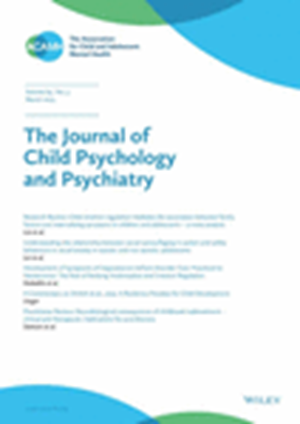Capturing change in restricted and repetitive behaviour in preschoolers with ASD: A comparison of direct behavioural observation and parent report.
IF 7
1区 医学
Q1 PSYCHIATRY
引用次数: 0
Abstract
BACKGROUND Restricted and repetitive behaviour (RRB) in autism spectrum disorder (ASD) can be assessed by different measures, which diverge in item quantity, dimensionality or source of information. However, change sensitivity has not been systematically investigated among commonly used measures, albeit its importance for clinical trials and longitudinal studies. METHODS Longitudinal data resulting from behavioural observation (Autism Diagnostic Observation Schedule-2, ADOS-2; Brief Observation of Social Communication Change, BOSCC) and parent report (Restricted Behaviour Scale-Revised, RBS-R) was collected for 134 toddlers and preschoolers aged 25-65 months diagnosed with ASD by the Autism Diagnostic Interview-Revised (ADI-R) and ADOS-2. Change sensitivity was estimated using the reliable-change index and developmental trajectories of RRB by linear mixed models and k-means clustering. RESULTS The RBS-R identified significantly more reliable change in RRB severity compared to ADOS-2 and BOSCC. For all measures, except the RBS-R self-injurious behaviour subscale, three distinct RRB trajectories were found as follows: increasing, stable and decreasing RRB severity. Overlap was low between trajectory group assignment across measures, as were cross-sectional correlations between ADI-R, ADOS-2, BOSCC and RBS-R. Trajectory group comparisons among measures mostly showed lower baseline RRB severity in the increasing trajectory groups and higher baseline RRB severity in the decreasing trajectory groups. The trajectory groups did not differ in age or nonverbal IQ across RRB measures, except for the RBS-R compulsive behaviour subscale, which had higher nonverbal IQ in the decreasing trajectory group. CONCLUSIONS The dimensional questionnaire RBS-R compared to ADOS-2 and BOSCC is superior in capturing subtle changes in RRB during preschool age.捕捉ASD学龄前儿童限制性和重复性行为的变化:直接行为观察与家长报告的比较。
自闭症谱系障碍(ASD)的限制性和重复性行为(RRB)可以通过不同的测量方法进行评估,这些测量方法在项目数量、维度或信息来源上存在差异。然而,尽管变化敏感性在临床试验和纵向研究中很重要,但在常用的测量方法中尚未系统地调查。方法行为观察(Autism Diagnostic observation Schedule-2, ADOS-2;本研究收集了134例25 ~ 65月龄的幼儿和学龄前儿童的社会交往变化简要观察(BOSCC)和家长报告(限制行为量表-修订版,RBS-R),这些儿童均采用自闭症诊断访谈-修订版(ADI-R)和ADOS-2进行诊断。利用可靠变化指数和RRB的发展轨迹,采用线性混合模型和k-means聚类估计变化敏感性。结果与ADOS-2和BOSCC相比,RBS-R识别RRB严重程度的变化更为可靠。除RBS-R自伤行为分量表外,所有测量结果均显示RRB严重程度增加、稳定和减少三个不同的轨迹。不同测量的轨迹组分配之间的重叠程度很低,ADI-R、ADOS-2、BOSCC和RBS-R之间的横截面相关性也很低。轨迹组之间的比较大多显示,轨迹增加组的基线RRB严重程度较低,轨迹减少组的基线RRB严重程度较高。轨迹组在RRB测量中的年龄和非语言智商没有差异,除了RBS-R强迫行为子量表,递减轨迹组的非语言智商更高。结论量表rb - r比ADOS-2和BOSCC更能捕捉学龄前儿童RRB的细微变化。
本文章由计算机程序翻译,如有差异,请以英文原文为准。
求助全文
约1分钟内获得全文
求助全文
来源期刊
CiteScore
13.80
自引率
5.30%
发文量
169
审稿时长
1 months
期刊介绍:
The Journal of Child Psychology and Psychiatry (JCPP) is a highly regarded international publication that focuses on the fields of child and adolescent psychology and psychiatry. It is recognized for publishing top-tier, clinically relevant research across various disciplines related to these areas. JCPP has a broad global readership and covers a diverse range of topics, including:
Epidemiology: Studies on the prevalence and distribution of mental health issues in children and adolescents.
Diagnosis: Research on the identification and classification of childhood disorders.
Treatments: Psychotherapeutic and psychopharmacological interventions for child and adolescent mental health.
Behavior and Cognition: Studies on the behavioral and cognitive aspects of childhood disorders.
Neuroscience and Neurobiology: Research on the neural and biological underpinnings of child mental health.
Genetics: Genetic factors contributing to the development of childhood disorders.
JCPP serves as a platform for integrating empirical research, clinical studies, and high-quality reviews from diverse perspectives, theoretical viewpoints, and disciplines. This interdisciplinary approach is a key feature of the journal, as it fosters a comprehensive understanding of child and adolescent mental health.
The Journal of Child Psychology and Psychiatry is published 12 times a year and is affiliated with the Association for Child and Adolescent Mental Health (ACAMH), which supports the journal's mission to advance knowledge and practice in the field of child and adolescent mental health.

 求助内容:
求助内容: 应助结果提醒方式:
应助结果提醒方式:


